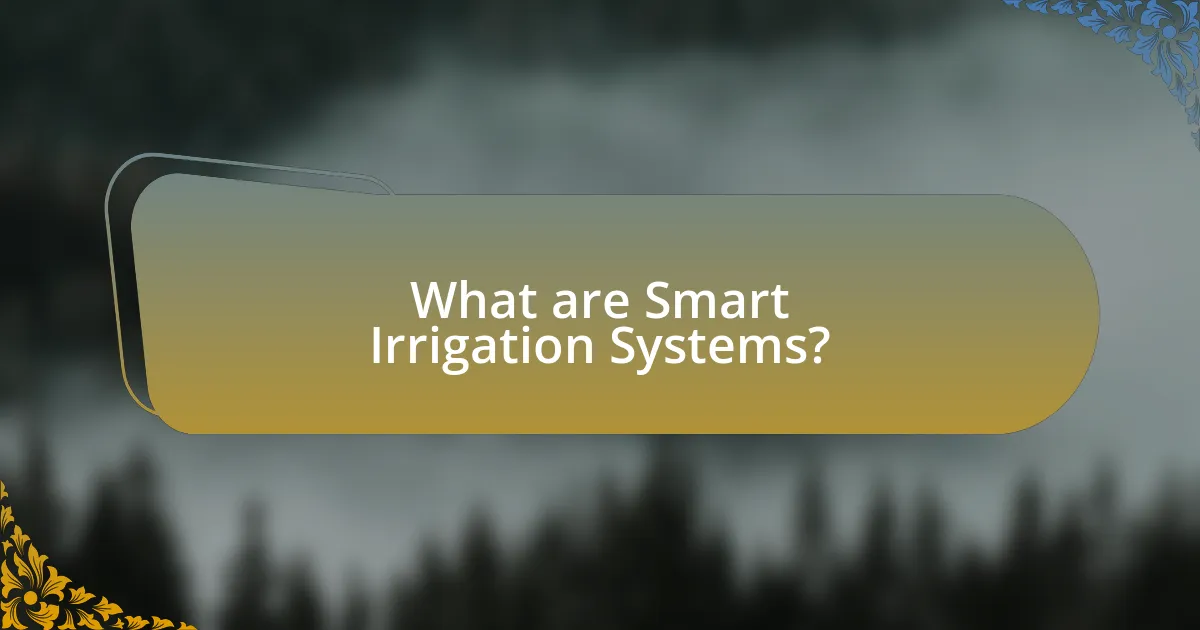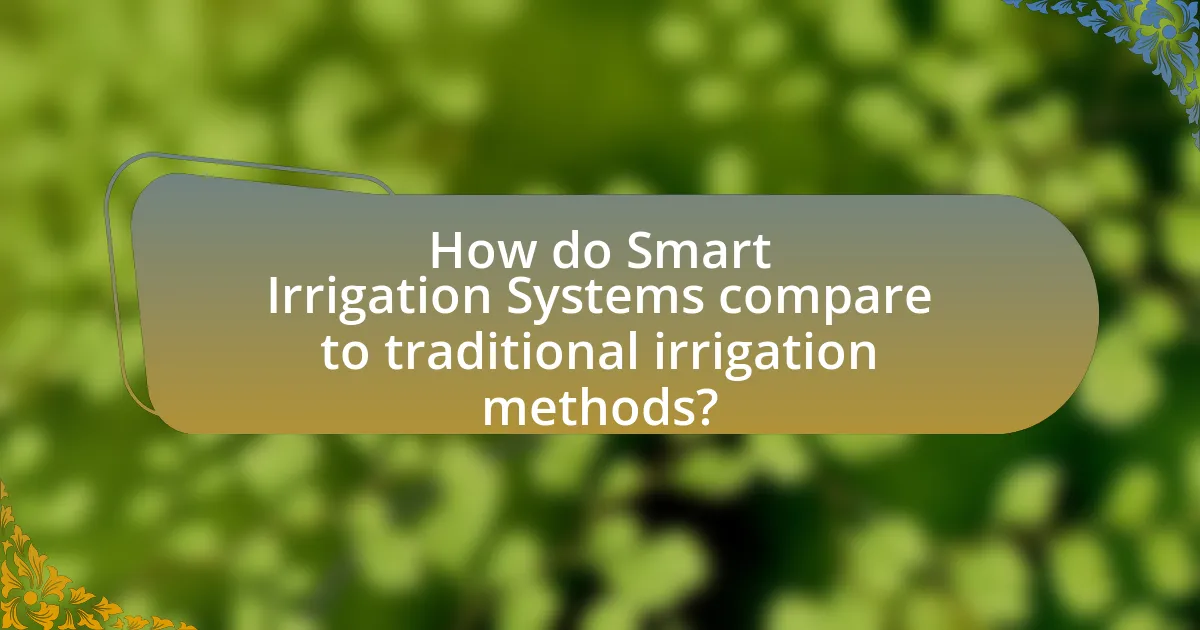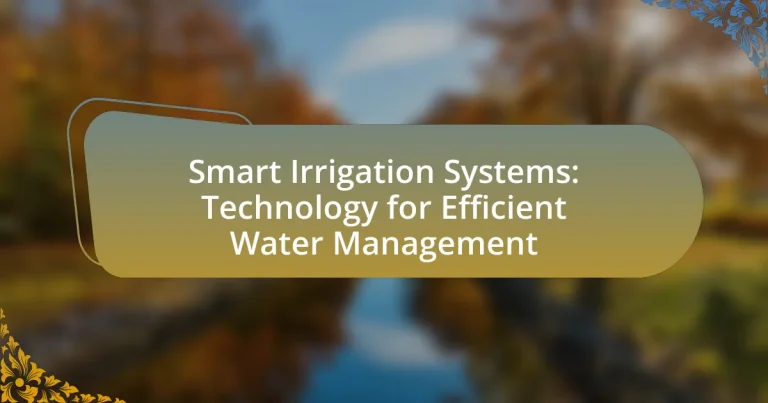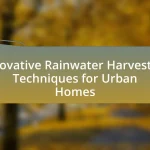Smart irrigation systems are advanced technologies that optimize water usage in agriculture and landscaping by utilizing sensors, weather data, and automated controls. These systems significantly reduce water waste, with studies indicating potential savings of up to 50% compared to traditional methods. The article explores the functioning of smart irrigation systems, the technologies integrated within them, their benefits, and the economic advantages for farmers. It also addresses the challenges and barriers to adoption, including costs and technical skills required, while highlighting best practices for effective use and maintenance. Overall, smart irrigation systems represent a crucial advancement in sustainable water management practices.

What are Smart Irrigation Systems?
Smart irrigation systems are advanced technologies designed to optimize water usage in agricultural and landscaping applications. These systems utilize sensors, weather data, and automated controls to deliver precise amounts of water based on real-time conditions, significantly reducing water waste. Research indicates that smart irrigation can reduce water consumption by up to 50% compared to traditional methods, enhancing efficiency and promoting sustainable water management practices.
How do Smart Irrigation Systems function?
Smart irrigation systems function by utilizing sensors, weather data, and automated controls to optimize water usage for irrigation. These systems monitor soil moisture levels, weather conditions, and plant water requirements to determine the precise amount of water needed. For instance, soil moisture sensors can detect when the soil is dry and trigger irrigation only when necessary, reducing water waste. Additionally, many smart irrigation systems integrate with weather forecasts to adjust watering schedules based on predicted rainfall or temperature changes, ensuring efficient water management. Studies have shown that these systems can reduce water usage by up to 30% compared to traditional irrigation methods, demonstrating their effectiveness in promoting sustainable water practices.
What technologies are integrated into Smart Irrigation Systems?
Smart Irrigation Systems integrate various technologies including soil moisture sensors, weather data analytics, and automated control systems. Soil moisture sensors measure the water content in the soil, allowing for precise irrigation based on actual needs rather than schedules. Weather data analytics utilize real-time weather information to adjust irrigation schedules, optimizing water usage based on rainfall predictions and temperature changes. Automated control systems enable remote management and programming of irrigation systems, enhancing efficiency and reducing water waste. These technologies collectively contribute to more sustainable water management practices in agriculture and landscaping.
How do sensors contribute to the efficiency of Smart Irrigation Systems?
Sensors enhance the efficiency of Smart Irrigation Systems by providing real-time data on soil moisture, weather conditions, and plant water needs. This data allows for precise irrigation scheduling, ensuring that water is applied only when necessary, which reduces water waste and promotes optimal plant growth. For instance, soil moisture sensors can detect when the soil reaches a specific moisture threshold, triggering irrigation only when required. Studies have shown that implementing sensor-based irrigation can lead to water savings of up to 30% compared to traditional methods, demonstrating their significant impact on water management efficiency.
What are the key benefits of Smart Irrigation Systems?
Smart irrigation systems provide efficient water management by optimizing water usage, reducing waste, and enhancing crop health. These systems utilize sensors and weather data to determine the precise watering needs of plants, which can lead to water savings of up to 50% compared to traditional irrigation methods. Additionally, smart irrigation can improve crop yields by ensuring that plants receive the right amount of water at the right time, thus promoting healthier growth and reducing the risk of over or under-watering.
How do Smart Irrigation Systems reduce water consumption?
Smart irrigation systems reduce water consumption by utilizing sensors and data analytics to optimize watering schedules and amounts based on real-time environmental conditions. These systems monitor factors such as soil moisture, weather forecasts, and plant water needs, allowing for precise irrigation that minimizes waste. For instance, studies have shown that smart irrigation can reduce water usage by up to 50% compared to traditional methods, as they only deliver water when necessary, preventing overwatering and runoff.
What economic advantages do Smart Irrigation Systems provide to farmers?
Smart Irrigation Systems provide significant economic advantages to farmers by optimizing water usage and reducing costs. These systems utilize sensors and data analytics to deliver precise amounts of water based on real-time conditions, which can lead to a reduction in water consumption by up to 30%. This efficiency not only lowers water bills but also minimizes energy costs associated with pumping and distributing water. Additionally, studies have shown that implementing smart irrigation can increase crop yields by 10-20%, further enhancing profitability. By investing in these technologies, farmers can achieve a quicker return on investment, often recouping costs within a few growing seasons.

How do Smart Irrigation Systems compare to traditional irrigation methods?
Smart irrigation systems are more efficient than traditional irrigation methods, primarily due to their ability to utilize real-time data and automation. Traditional irrigation often relies on fixed schedules and manual adjustments, leading to overwatering or underwatering, which can waste water and reduce crop yield. In contrast, smart systems employ sensors and weather data to optimize water usage, resulting in up to 30-50% water savings, as reported by the USDA. Additionally, smart irrigation can improve crop health by delivering precise amounts of water based on plant needs, enhancing overall agricultural productivity.
What are the limitations of traditional irrigation systems?
Traditional irrigation systems have several limitations, including inefficiency in water usage, high labor costs, and susceptibility to environmental factors. These systems often rely on flood or surface irrigation methods, which can lead to significant water loss through evaporation and runoff, with studies indicating that up to 50% of water can be wasted in such systems. Additionally, traditional methods require substantial manual labor for setup and maintenance, increasing operational costs. Furthermore, they are vulnerable to weather conditions, such as droughts or heavy rainfall, which can disrupt water supply and crop yields.
How does water waste occur in traditional irrigation methods?
Water waste occurs in traditional irrigation methods primarily due to inefficient water application techniques. These methods often involve surface irrigation, where water is applied directly to the soil surface and allowed to flow over the field, leading to significant evaporation and runoff. Research indicates that traditional irrigation can result in water losses of up to 50% due to these factors, as water is not effectively utilized by crops. Additionally, the lack of precise control over water distribution in traditional systems contributes to overwatering in some areas and underwatering in others, further exacerbating water waste.
What are the environmental impacts of traditional irrigation practices?
Traditional irrigation practices lead to significant environmental impacts, including water depletion, soil degradation, and increased salinity. These practices often rely on surface water sources, which can result in over-extraction and reduced water availability for ecosystems. For instance, excessive water withdrawal from rivers can disrupt aquatic habitats and diminish biodiversity. Additionally, traditional irrigation methods can cause soil erosion and nutrient leaching, reducing soil fertility over time. Furthermore, the accumulation of salts in the soil, often exacerbated by inefficient water application, can render land unproductive. Studies indicate that approximately 20% of irrigated land suffers from salinity issues, affecting crop yields and sustainability.
What advancements have been made in Smart Irrigation technology?
Recent advancements in Smart Irrigation technology include the integration of IoT sensors, machine learning algorithms, and real-time data analytics. These technologies enable precise monitoring of soil moisture levels, weather conditions, and plant water requirements, leading to optimized water usage. For instance, studies have shown that IoT-enabled systems can reduce water consumption by up to 30% while maintaining crop yield. Additionally, machine learning models can predict irrigation needs based on historical data, further enhancing efficiency. These innovations collectively contribute to sustainable water management practices in agriculture.
How has IoT influenced the development of Smart Irrigation Systems?
IoT has significantly influenced the development of Smart Irrigation Systems by enabling real-time data collection and automated control of irrigation processes. This technology allows for precise monitoring of soil moisture, weather conditions, and crop needs, leading to optimized water usage. For instance, a study by the University of California found that IoT-based systems can reduce water consumption by up to 30% while maintaining crop yield. By integrating sensors and connectivity, IoT facilitates data-driven decision-making, enhancing the efficiency and sustainability of agricultural practices.
What role does data analytics play in optimizing irrigation schedules?
Data analytics plays a crucial role in optimizing irrigation schedules by enabling precise water management based on real-time data. By analyzing factors such as soil moisture levels, weather forecasts, and crop water requirements, data analytics helps farmers determine the optimal timing and amount of water needed for irrigation. For instance, a study published in the journal “Agricultural Water Management” found that using data-driven irrigation scheduling can reduce water usage by up to 30% while maintaining crop yield, demonstrating the effectiveness of analytics in enhancing irrigation efficiency.

What are the challenges in implementing Smart Irrigation Systems?
The challenges in implementing Smart Irrigation Systems include high initial costs, technical complexity, and the need for reliable data. High initial costs can deter farmers from adopting these systems, as investments in technology, sensors, and infrastructure can be substantial. Technical complexity arises from the integration of various technologies, requiring specialized knowledge for installation and maintenance. Additionally, reliable data is essential for effective operation; without accurate weather forecasts and soil moisture data, the systems may not function optimally, leading to inefficient water usage. These challenges highlight the barriers to widespread adoption of Smart Irrigation Systems in agricultural practices.
What are the common barriers to adoption for farmers?
Common barriers to adoption for farmers include high initial costs, lack of technical knowledge, and limited access to financing. High initial costs deter farmers from investing in smart irrigation systems, as they may not have the capital to cover expenses upfront. Additionally, a lack of technical knowledge can hinder farmers’ ability to effectively implement and manage these systems, leading to concerns about their practicality and efficiency. Limited access to financing options further exacerbates these challenges, as farmers may struggle to secure loans or grants necessary for purchasing advanced technology. According to a study by the Food and Agriculture Organization, these barriers significantly impact the adoption rates of innovative agricultural technologies, including smart irrigation systems.
How does the cost of Smart Irrigation Systems affect their adoption?
The cost of Smart Irrigation Systems significantly affects their adoption, as higher initial investments can deter potential users. Many farmers and landowners face budget constraints, making them hesitant to invest in technology that may not yield immediate financial returns. For instance, a study by the American Society of Agricultural and Biological Engineers found that the upfront costs of smart irrigation systems can range from $1,000 to $5,000 per acre, which can be prohibitive for smaller operations. Consequently, this financial barrier limits the widespread implementation of these systems, despite their long-term benefits in water conservation and efficiency.
What technical skills are required to operate Smart Irrigation Systems?
To operate Smart Irrigation Systems, individuals require technical skills in system installation, programming, and data analysis. Proficiency in installing sensors and controllers is essential for setting up the irrigation system effectively. Additionally, knowledge of programming is necessary to configure the system for optimal water usage based on environmental data. Data analysis skills are crucial for interpreting sensor readings and adjusting irrigation schedules accordingly, ensuring efficient water management. These skills collectively enable operators to maximize the functionality and efficiency of Smart Irrigation Systems.
How can farmers overcome these challenges?
Farmers can overcome challenges related to water management by implementing smart irrigation systems that utilize technology for efficient water use. These systems, such as drip irrigation and automated scheduling, optimize water delivery based on real-time data, reducing waste and improving crop yields. Research indicates that smart irrigation can lead to water savings of up to 30% while maintaining or increasing agricultural productivity. By adopting these technologies, farmers can effectively address water scarcity and enhance sustainability in their operations.
What resources are available for training on Smart Irrigation Systems?
Resources available for training on Smart Irrigation Systems include online courses, workshops, and certification programs offered by various agricultural and environmental organizations. For instance, the USDA provides educational materials and training sessions focused on smart irrigation technologies, while universities such as the University of California and Colorado State University offer specialized courses in precision agriculture and irrigation management. Additionally, platforms like Coursera and edX feature courses on sustainable water management that cover smart irrigation practices. These resources are designed to enhance knowledge and skills in implementing efficient irrigation systems, supported by research and practical applications in the field.
How can financial incentives support the transition to Smart Irrigation?
Financial incentives can significantly support the transition to Smart Irrigation by reducing the initial investment costs for farmers and encouraging the adoption of advanced technologies. These incentives, such as grants, subsidies, or tax breaks, lower the financial barrier that often prevents farmers from investing in smart irrigation systems, which can include sensors, automated controls, and data analytics tools. For instance, a study by the USDA found that financial assistance programs can lead to a 30% increase in the adoption rate of water-efficient technologies among farmers. By making smart irrigation more affordable, financial incentives not only promote sustainable water management practices but also enhance crop yields and reduce water waste, ultimately benefiting both the environment and agricultural productivity.
What are best practices for using Smart Irrigation Systems effectively?
To use Smart Irrigation Systems effectively, implement scheduling based on weather forecasts and soil moisture levels. This practice ensures that irrigation occurs only when necessary, reducing water waste. Research indicates that utilizing real-time data from weather stations and soil sensors can lead to water savings of up to 30% compared to traditional irrigation methods. Additionally, regularly maintaining and calibrating the system enhances its efficiency and performance, ensuring optimal water delivery to plants.
How can farmers monitor and adjust their irrigation schedules?
Farmers can monitor and adjust their irrigation schedules by utilizing smart irrigation systems that incorporate soil moisture sensors, weather data, and automated controls. These systems provide real-time data on soil moisture levels, allowing farmers to determine when and how much to irrigate based on actual crop needs rather than fixed schedules. Research indicates that using soil moisture sensors can reduce water usage by up to 30%, as they enable precise irrigation timing and volume based on environmental conditions. Additionally, integrating weather forecasts helps farmers anticipate rainfall and adjust irrigation accordingly, further optimizing water management.
What maintenance tips ensure the longevity of Smart Irrigation Systems?
Regular maintenance of Smart Irrigation Systems is essential for their longevity. Key maintenance tips include checking and cleaning filters and emitters to prevent clogging, inspecting and repairing leaks in pipes and connections, and ensuring that sensors are functioning correctly to optimize water usage. Additionally, seasonal adjustments to the irrigation schedule based on weather conditions and plant needs help maintain efficiency. Routine system evaluations can identify potential issues early, thereby extending the system’s lifespan. These practices are supported by studies indicating that proper maintenance can enhance system performance and reduce water waste, ultimately leading to more sustainable water management.


